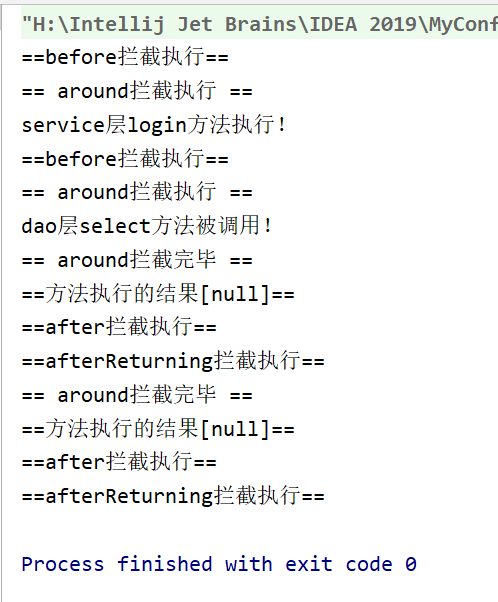
首先是 applicationContext.xml(核心配置文件):
配置文件:
首先,我们需要在配置文件的头部,beans标签的属性中 加上aop命名空间:
xmlns:aop="http://www.springframework.org/schema/aop"
xsi:schemaLocation="http://www.springframework.org/schema/aop
https://www.springframework.org/schema/aop/spring-aop.xsd"
仅加入aop命名空间后,配置文件内容如下:
<?xml version="1.0" encoding="UTF-8"?>
<beans xmlns="http://www.springframework.org/schema/beans"
xmlns:xsi="http://www.w3.org/2001/XMLSchema-instance"
xmlns:context="http://www.springframework.org/schema/context"
xmlns:aop="http://www.springframework.org/schema/aop"
xsi:schemaLocation="http://www.springframework.org/schema/beans
http://www.springframework.org/schema/beans/spring-beans.xsd
http://www.springframework.org/schema/context
https://www.springframework.org/schema/context/spring-context.xsd
http://www.springframework.org/schema/aop
https://www.springframework.org/schema/aop/spring-aop.xsd">
</beans>
那么,配置文件式 也存在着两种使用方式,本人在这里一一来讲解下:
方式一 —— 原生 spring API接口:
配置文件 语法:
在beans标签内,增加如下子级标签,导入aop约束:
<aop:config>
<!--aop配置内容-->
</aop:config>
在config标签内部,配置aop的内容:
config配置内容,总共分为三类:
配置内容 分类:
- 用于配置切面
在第二种使用方式中会进行讲解:
<aop:aspect/>
- 用于配置切入点:
<aop:pointcut id="切入点id" expression="execution(表达式)"/>
现在,本人来讲解下 上述表达式的语法
表达式语法:
权限名 返回值类型 类的全路径名.目标方法名(参数全路径类型1, 参数全路径类型2 ...)
那么,我们在使用的时候也可以对其进行简化:
简化:
- 权限名可以省略
- 返回值可以设置为 '*',表示任意返回值都能匹配上
- 包名可以用'.'代替,表示其父包下的所有子包都能匹配上
- 类名/方法名 可以设置为'*',表示 其父包下的所有类/其所属类中的所有方法 都能匹配上
- 参数可以用'. .'代替,表示任意个数、任意种类的参数都能被匹配上
- 用于为切入点配置拦截器:
<aop:advisor advice-ref="横切关注点的bean id" pointcut="切入点 id" />
那么,我们该如何去定义一个拦截器呢?
定义拦截器 语法:
首先,我们需要写一个类,继承如下四个几口中的一个:
MethodBeforeAdvice接口 —— 提供前置拦截方法:
参数:
- method:
被拦截的方法(即:切入点)- objects:
执行该方法的参数- Object o:
执行该方法的代理对象
AfterReturningAdvice接口 —— 提供最终拦截方法:
参数:
- returnValue:
目标方法(即:切入点)的返回值- method:
目标方法(即:切入点)- args:
目标方法(即:切入点)的参数- target:
执行该方法的代理对象
MethodInterceptor接口 —— 提供环绕拦截方法:
提供 public Object invoke(MethodInvocation invocation) throws Throwable 方法
参数类型MethodInvocation,主要是用于 获取 目标对象 以及 方法信息 的
ThrowsAdvice接口 —— 提供异常抛出拦截方法
无需要重写的方法
那么,现在本人就来展示下方式一的使用:
使用展示:
首先,本人给出一个dao层实现类:
package edu.youzg.about_aop.test.dao;
import org.springframework.stereotype.Repository;
/**
* @Author: Youzg
* @CreateTime: 2020-05-01 20:31
* @Description:带你深究Java的本质!
*/
@Repository
public class UserDaoImpl implements IUserDao {
@Override
public void add() {
System.out.println("dao层add方法被调用!");
}
@Override
public void delete() {
System.out.println("dao层delete方法被调用!");
}
@Override
public void alter() {
System.out.println("dao层alter方法被调用!");
}
@Override
public void select() {
System.out.println("dao层select方法被调用!");
}
}
接下来,本人来给出一个service层的实现类:
package edu.youzg.about_aop.test.service;
import edu.youzg.about_aop.test.dao.IUserDao;
import org.springframework.beans.factory.annotation.Autowired;
import org.springframework.stereotype.Service;
/**
* @Author: Youzg
* @CreateTime: 2020-05-01 20:33
* @Description:带你深究Java的本质!
*/
@Service
public class UserServiceImpl implements IUserService {
@Autowired
private IUserDao userDao;
@Override
public void login() {
System.out.println("service层login方法执行!");
userDao.select();
}
@Override
public void register() {
System.out.println("service层register方法执行!");
userDao.add();
}
@Override
public void rename() {
System.out.println("service层rename方法执行!");
userDao.alter();
}
@Override
public void cancellat() {
System.out.println("service层cancellat方法执行!");
userDao.delete();
}
}
现在,本人来给出一个通知器类:
package edu.youzg.about_aop.test.aspect;
import org.springframework.aop.MethodBeforeAdvice;
import org.springframework.stereotype.Component;
import java.lang.reflect.Method;
@Component //将其注入IoC容器中
public class MyAspect implements MethodBeforeAdvice { //继承Adice接口,实现其自带方法,成为一个拦截器(通知器)
@Override
public void before(Method method, Object[] objects, Object o) throws Throwable {
System.out.println("===== Youzg代理执行 之 前置增强 =====");
}
}
最后,现在本人 来给出配置文件:
<?xml version="1.0" encoding="UTF-8"?>
<beans xmlns="http://www.springframework.org/schema/beans"
xmlns:xsi="http://www.w3.org/2001/XMLSchema-instance"
xmlns:context="http://www.springframework.org/schema/context"
xmlns:aop="http://www.springframework.org/schema/aop"
xsi:schemaLocation="http://www.springframework.org/schema/beans
http://www.springframework.org/schema/beans/spring-beans.xsd
http://www.springframework.org/schema/context
https://www.springframework.org/schema/context/spring-context.xsd
http://www.springframework.org/schema/aop
https://www.springframework.org/schema/aop/spring-aop.xsd">
<context:component-scan base-package="edu.youzg.about_aop" />
<aop:config>
<!-- 定义拦截器 -->
<aop:advisor advice-ref="myAspect" pointcut="execution(* edu.youzg.about_aop..*.*(..))" />
</aop:config>
</beans>
最后,本人再来给出一个测试类
package edu.youzg.about_aop.test;
import edu.youzg.about_aop.test.service.IUserService;
import org.springframework.context.ApplicationContext;
import org.springframework.context.support.ClassPathXmlApplicationContext;
/**
* @Author: Youzg
* @CreateTime: 2020-05-01 23:11
* @Description:带你深究Java的本质!
*/
public class Test {
public static void main(String[] args) {
ApplicationContext context = new ClassPathXmlApplicationContext("applicationContext.xml");
IUserService userService = context.getBean("userServiceImpl", IUserService.class);
userService.login();
}
}
那么,现在本人来展示下运行结果:

方式二 —— 自定义类实现AOP机制:
方式二的通知有五个类型:
分类:
- 前置通知
- 后置通知
- 最终通知
- 环绕通知
- 异常通知
格式:
首先得配置一个自定义拦截器类:
接下来是配置文件:
配置文件:
<aop:config>
<aop:aspect id="切面bean id" ref="切面">
<!--切入点-->
<aop:pointcut id="自定义拦截器 bean id" expression="execution(表达式)"/>
<!--五种通知类型-->
<!--前置通知-->
<aop:before method="前置拦截方法名" pointcut-ref="切入点id" />
<!--最终通知-->
<aop:after-returning method="最终拦截方法名" pointcut-ref="切入点id" />
<!--后置通知-->
<aop:after method="后置拦截方法名" pointcut-ref="切入点id" />
<!--环绕通知-->
<aop:around method="环绕拦截方法名" pointcut-ref="切入点id" />
<!--异常通知-->
<aop:after-throwing method="异常拦截方法名" pointcut-ref="切入点id" />
</aop:aspect>
</aop:config>
为了方便,在上文中,本人将所有通知方式都在一起展示了
那么,我们在使用的时候,只需要针对需求选取其中几种就行
那么,现在本人来展示下方式二的使用:
使用展示:
首先,本人来给出一个自定义拦截器类:
package edu.youzg.about_aop.test.aspect;
import org.aspectj.lang.ProceedingJoinPoint;
import org.springframework.stereotype.Component;
/**
* @Author: Youzg
* @CreateTime: 2020-05-01 21:56
* @Description:带你深究Java的本质!
*/
@Component
public class YouzgAspect {
public void myBefore() {
System.out.println("==before拦截执行==");
}
public void myAfter() {
System.out.println("==after拦截执行==");
}
public void myAfterReturning() {
System.out.println("==afterReturning拦截执行==");
}
public void myThrowing() {
System.out.println("==throwing拦截执行==");
}
public Object myAround(ProceedingJoinPoint pjp) {
Object result = null;
try {
System.out.println("== around拦截执行 ==");
result = pjp.proceed();
// 方法执行完毕之后编写
System.out.println("== around拦截完毕 ==");
System.out.println("==方法执行的结果[" + result + "]==");
}catch(Throwable t){
// 可以处理,异常通知
System.out.println("异常处理");
}
return result;
}
}
现在,本人来给出配置文件的信息:
<?xml version="1.0" encoding="UTF-8"?>
<beans xmlns="http://www.springframework.org/schema/beans"
xmlns:xsi="http://www.w3.org/2001/XMLSchema-instance"
xmlns:context="http://www.springframework.org/schema/context"
xmlns:aop="http://www.springframework.org/schema/aop"
xsi:schemaLocation="http://www.springframework.org/schema/beans
http://www.springframework.org/schema/beans/spring-beans.xsd
http://www.springframework.org/schema/context
https://www.springframework.org/schema/context/spring-context.xsd
http://www.springframework.org/schema/aop
https://www.springframework.org/schema/aop/spring-aop.xsd">
<context:component-scan base-package="edu.youzg.about_aop" />
<aop:config>
<aop:aspect id="youzgAsp" ref="youzgAspect">
<!--切入点-->
<aop:pointcut id="youzgPoingcut" expression="execution(* edu.youzg.about_aop..*.*(..))"/>
<!--五种通知类型-->
<!--前置通知-->
<aop:before method="myBefore" pointcut-ref="youzgPoingcut" />
<!--后置通知-->
<aop:after-returning method="myAfterReturning" pointcut-ref="youzgPoingcut" />
<!--最终通知-->
<aop:after method="myAfter" pointcut-ref="youzgPoingcut" />
<!--环绕通知-->
<aop:around method="myAround" pointcut-ref="youzgPoingcut" />
<!--异常通知-->
<aop:after-throwing method="myThrowing" pointcut-ref="youzgPoingcut" />
</aop:aspect>
</aop:config>
</beans>
最后,本人再来给出一个测试类
package edu.youzg.about_aop.test;
import edu.youzg.about_aop.test.service.IUserService;
import org.springframework.context.ApplicationContext;
import org.springframework.context.support.ClassPathXmlApplicationContext;
/**
* @Author: Youzg
* @CreateTime: 2020-05-01 23:11
* @Description:带你深究Java的本质!
*/
public class Test {
public static void main(String[] args) {
ApplicationContext context = new ClassPathXmlApplicationContext("applicationContext.xml");
IUserService userService = context.getBean("userServiceImpl", IUserService.class);
userService.login();
}
}
那么,现在本人来展示下运行结果: